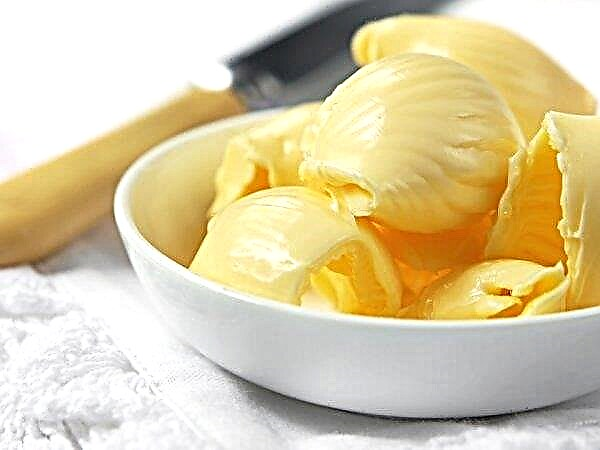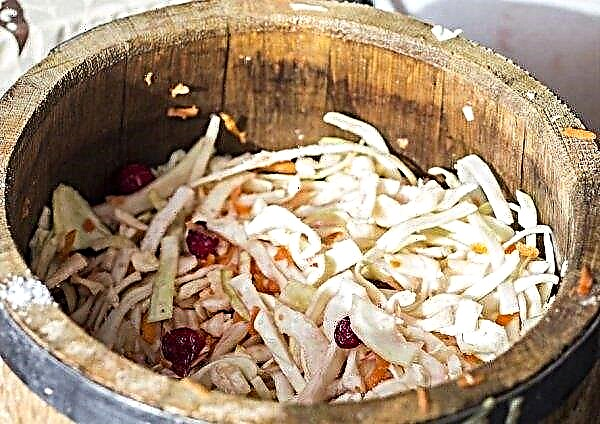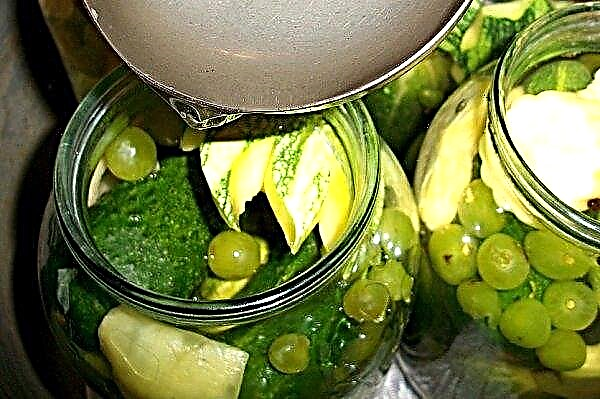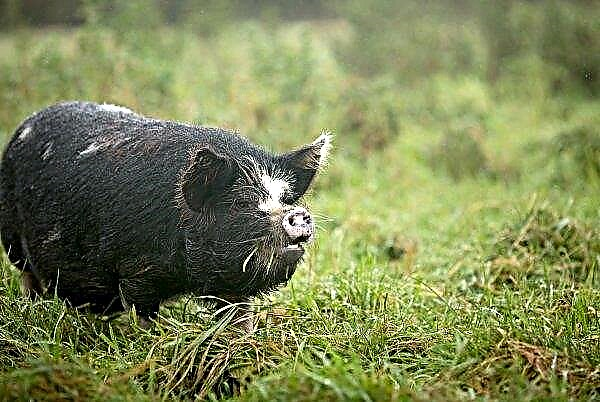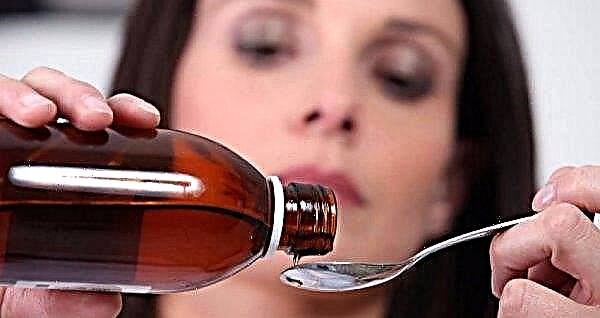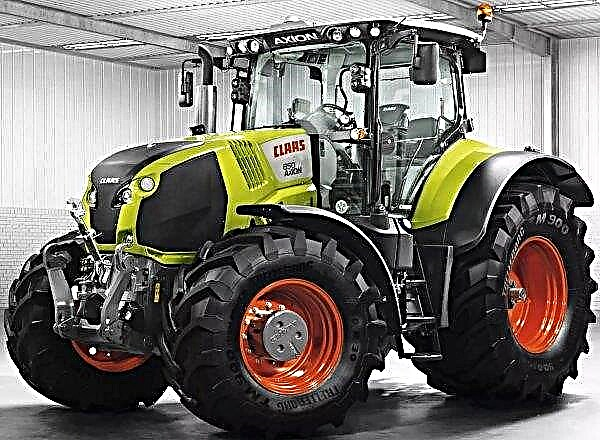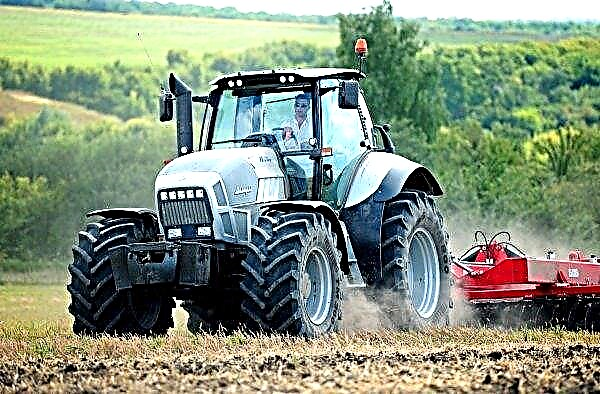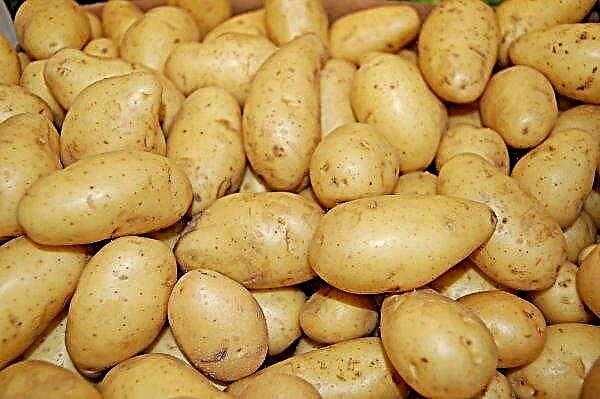Juniper, which saves year-round decorativeness, is popular among landscape designers, as well as owners of house plots. To choose the right plant for growing, you need to familiarize yourself with the description and characteristics of several varieties. The article will discuss the rocky juniper Skyrocket.
Botanical Description
Juniper rocky Skyrocket (Juniperus scopulorum Skyrocket) grows to a height of 5–7 m. Its crown reaches 1 m in diameter. It resembles a cone in shape. As you grow older, shrubs rounded outlines.
Branches grow up. They are straight. The needles are small, scaly, painted in blue-green or bluish color. In length, it reaches 1–2 mm, in width - 0.5–1 mm.

During fruiting, which begins in the second year after planting, cones with a diameter of 4–6 mm are formed. Their shape is spherical. Their surface is painted dark blue with a blue coating. Cones contain 2-3 seeds of red-brown color.
In vivo juniper grows in North America, found in the USA, Canada, Mexico. The rocky view is very close to the virgin (Juniperus virginiana), but has some differences with it, for example, thinner and stiffer shoots.
Did you know? Juniper bushes planted on a 1-hectare site daily evaporate about 30 kg of volatile production. This volume is enough to clear the air of pathogens in a large settlement.
Variety Characteristics
The Skyrocket variety has many advantages. Thanks to them, there are great opportunities for growing this conifer in cottages, gardens, and suburban areas. It is suitable for planting in city parks.
This juniper is appreciated due to such characteristics:
- high level of frost resistance - up to –30 ° С;
- compactness;
- drought tolerance;
- wind resistance;
- normal portability of city conditions;
- good annual growth rates - 15–20 cm in height, 5 cm in width.

Landing rules
In order for the juniper to grow and develop correctly, you should choose a successful site in accordance with its requirements and choose a quality planting material. In addition, it is worthwhile to properly prepare the ground and adhere to the technology when planting. Juniper does not like it if its roots are disturbing, so it is important to handle them carefully when planting. The root neck should also be positioned correctly. Only if all the rules are observed there is every chance that the seedling will quickly take root.
Site preparation
Juniper Skyrocket cannot stand shade or even partial shade. In shaded places, it withers, loses its decorativeness, therefore, for planting this culture, you should choose well-lit and sheltered from the winds areas.
Juniper is not picky about soil. However, it does not tolerate salinity and stagnation of water. The best soil for growing shrubs is light loam with a neutral or slightly acidic pH.
 It is important to measure the acidity of the soil and, if necessary, lower it to 6–7 pH by adding hydrated lime or dolomite flour
It is important to measure the acidity of the soil and, if necessary, lower it to 6–7 pH by adding hydrated lime or dolomite flour
The place where it is planned to plant juniper must be cleaned of plant debris and dig on a bayonet shovel. If you plan to plant several plants, then between the pits should be maintained at intervals of 1-2 m.
A landing pit should be dug 2-3 weeks before the planned landing. It needs to be made 2-3 times more than an earthen coma of a seedling and a depth of 70 cm. A drainage layer 20 cm high of coarse sand or broken brick should be laid on its bottom. To fill the pit, you need to prepare a mixture of peat, sand, turf land in a ratio of 2: 1: 1.
Selection and preparation of seedlings
To purchase a seedling, you should go to a gardening shop or nursery. It is better to purchase planting material with a closed root system - in a container or, in extreme cases, with an earthen lump wrapped in burlap.
Damage to the roots during the planting phase may be detrimental to the juniperTherefore, it is important to transplant it from the container carefully, without destroying the earthen coma. If any part of the roots is exposed, then they need to be treated with a rooting agent.

When choosing a seedling, you should pay attention to such characteristics:
- the crown is painted in a uniform color;
- the bark is smooth, without cracks;
- fresh shoots, grow straight;
- 3-4 years old.
The landing process is quite simple and consists of the following steps:
- A day before the planned movement of the seedling in the open ground, water the soil in a container.
- Put a small amount of soil mix prepared in advance on the drainage layer in the planting pit.
- Carefully remove the earthen lump.
- Set the seedling in the center of the pit.
- Fill the voids with the remaining soil mixture.
- Compact the earth.
- Dig a shallow furrow around the circumference of the near-trunk zone, retreating 20–25 cm from the trunk.
- Slowly pour 10 liters of water into it.
- Bind the seedling trunk to the planting stake.
- Mulch the near-trunk zone with wood chips, bark, peat or pine cones.

Features of plant care
Juniper will grow well and develop properly if it is well looked after. The list of mandatory measures includes hydration, fertilizing, soil care. Annual pruning and wintering preparations are also required.
Video: Characteristics of Juniper Skyrocket
Watering and feeding
Juniper bushes do not tolerate dry soil and air, therefore it is important to organize the correct irrigation regime for them, especially in the first 2-3 years after planting. Shrubs need to be moistened with a frequency of once a week. One plant needs 5-10 liters of water.
In the summer, it is advisable to water the crown of the juniper by sprinkling - using a hose with a diffused stream. This procedure is especially needed for conifers growing in the city. It allows you to wash away dirt and dust from the needles, to make it brighter.

Like any plant, juniper needs periodic top dressing. However, they are often not required to be made. It will be enough once a year, in April - May, to make mineral fertilizers. For this purpose, complex compounds, for example, Kemira Universal, or special fertilizers for conifers - Uniflora, Agricole, are suitable.
Important! Organic matter, especially manure, and also nitrogen-containing complexes cannot be added under juniper. This can harm the plant and lead to developmental disorders.
Mulching
After watering and rains, the soil in the near-stem zone should be loosened. This will prevent the formation of a hard crust on the surface, which does not allow water and air to pass to the roots. Since the roots of the juniper are close, loosening should be shallow and accurate.
To less often water and weed, you need to mulch. Mulch from peat, cones, needles, sawdust should be laid with a layer of 5-8 cm. It will help to maintain the optimum moisture level, slow down the growth of weeds, improve the soil condition. In winter, using it, the root system is heated.

Haircut and Shaping
Artificial crown formation for juniper Skyrocket is not needed. Him only annual sanitary scraps are needed. In spring and summer, it is necessary to cut the sick, yellowed, twisted, branches growing inside the crown.
When trimming, use only pre-sanitized devices.. It is unacceptable to use the same tool without disinfection for cutting different plants - this can transmit the disease in case of infection of any of them. Slices should be treated with copper sulphate and coated with garden varieties or RanNet paste.

Winter preparations
Only young plants can suffer from frost, so their crowns should be covered with burlap, agrofibre after the first frost. Adult plants can greatly damage the first spring sunshine. For this reason, it is worth wrapping their crowns in February with material that does not transmit the light of the sun. Such a shelter should be removed in April, when the threat of burns is over.
The root system is also worth insulating. To do this, in the near-stem zone, a 10-centimeter layer of mulch, for example, from peat, should be laid.
Juniper Skyrocket, like other conifers with columnar crown, is susceptible to damage during heavy leaf falls, so before winter, the branches must be tied with a rope or ribbon to the trunk.

Diseases and Pests
The owner of the juniper should be prepared for the fact that when growing it, you can encounter various problems associated with the growth and development of the bush. For example, soil bays resulting from improper irrigation or floods, rising groundwater levels can lead to yellowing, drying out and falling of needles. Sudden changes in temperature, spring frosts, the first scorching rays of the sun damage the bark, needles, roots.
Another misfortune that can befell rocky juniper, are diseases caused by fungi.
You can protect yourself from them by preventive measures:
- Autumn cleaning of the site from plant debris.
- Deep digging of a near-stem circle on a bayonet of a shovel.
- Planting a healthy seedling.
- Sanitary pruning of shoots.
- Regular inspection of the bush.
- Strengthening immunity by applying mineral fertilizers.
- Soil care - moisturizing, loosening, weeding, mulching.
- Shelter before the winter.
If you still have not managed to avoid infection, you need to make a diagnosis based on the symptoms as soon as possible and begin treatment.

The information in the table will help you choose the right method of therapy:
| Disease name | Symptoms of infection | Treatment methods |
| Alternariosis |
|
|
| Rust |
|
|
| Fusarium |
|
|
| Schütte ordinary |
| Use for processing shrubs Bordeaux fluid, means "HOM", "Ridomil Gold MC", etc. |
| Schütte brown |
| The use of funds "Quadris", "Ridomil Gold MC", "Strobi" and others. |
Insects leading a parasitic lifestyle can cause great harm to the decorativeness of juniper bushes.

The most dangerous are the following pests:
| Insect name | Symptoms of lesion | Disposal methods |
| Gallitsa |
|
|
| Flattening mite |
| Spraying with acaricides - for example, “Actellicum”, “Caesar” |
| Sawfly |
|
|
| Aphid |
|
|
| Shield |
|
|
| Winged pine moth |
| The use in the spring and summer periods of insecticidal preparations with a wide spectrum of action. |
| Mealybug |
| Use of means "Angio." |
Important! Since pathogens and pests can adapt to the components of chemicals, developing resistance to them, they should be alternated from year to year.
Breeding
To multiply juniper, you can apply 2 ways: seed and vegetative. The first of them is not practiced at home due to troubles and duration. It is used only by breeders. Gardeners resort to propagation by cuttings and layering.

Cuttings are made from April to May. Cuttings are cut during sanitary pruning from semi-lignified branches. When harvesting, it is important to leave part of the uterine plant (“heel”). From the bottom of the handle, it is worth trimming all shoots growing at a height of 3-4 cm.
Did you know? Juniper is a long-lived tree that can live up to 600 years. The fossil remains of this plant in the territory of modern Russia and neighboring states were found in the Shinguistaya region, the Archeda river, and Lake Balkhash.
In the future, when propagating, proceed as follows:
- Place a cut of the cut in the rooting agent.
- Plant it in a soil mixture consisting of sand and peat in a ratio of one to one.
- Arrange shelter, good lighting, temperature and humidity, as in a mini-greenhouse or greenhouse.
- Water as the topsoil dries.
- Take cover every day to give an influx of fresh air and prevent the development of fungal diseases.
- After 1-1.5 months after the appearance of the roots, remove the shelter.
 Then you can go in two ways: to land on a permanent place after 3 months or do it next spring
Then you can go in two ways: to land on a permanent place after 3 months or do it next spring
Multiplication by layering - an easier way. In order to implement it, it is necessary to bend the strong branches of the lower tier of 3-5 years old in spring to bend to the ground, make notches on them, departing 10-15 cm from each other, lay in a pre-dug trench, dig and fix. Buried branches should be watered regularly. In the autumn, sprouts should appear from the notches. They can be separated from the mother bush next spring. After separation, you can put the plants for growing or plant in open ground in a permanent place.

Use in landscape design
The Skyrocket variety is recommended for cultivation in small areas as a vertical element in decorative compositions. It is used in rock gardens, heather gardens, also planted on lawns, in alley plantings, used to form hedges. Juniper looks beautiful in combination with other coniferous, herbaceous and flowering plants. It is well adjacent to heather, eric, pine, roses, perennial and cereal crops.

Summing up, it should be said that the rocky juniper of the Skyrocket variety is worth a look at the owners of summer cottages, especially small ones.In addition to good lighting, he does not put forward serious requirements for growing conditions and does not require painstaking care. The shrub is suitable for decorating the landscape, creating a variety of decorative compositions.

